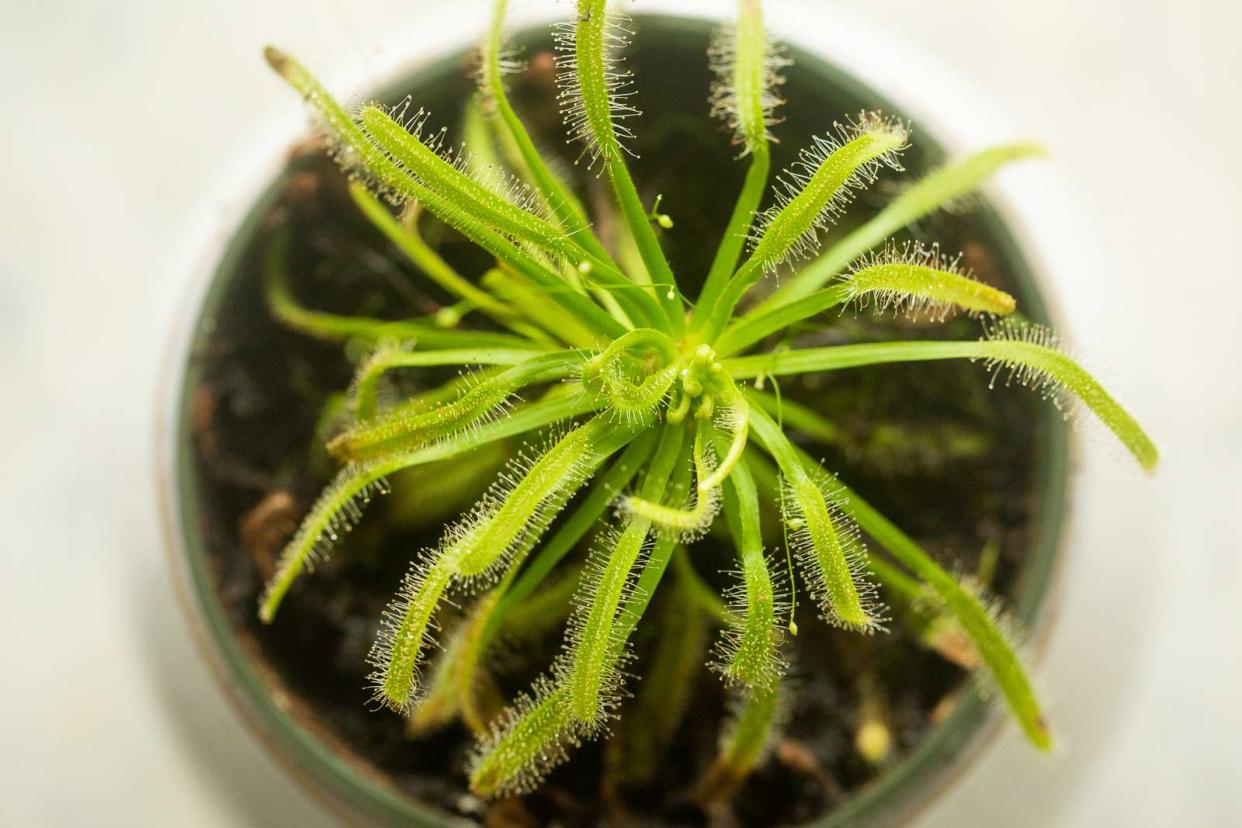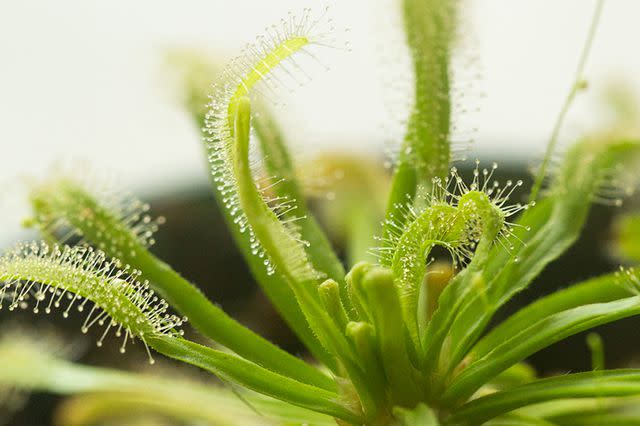How to Grow and Care for Sundew Plants

The Spruce / Phoebe Cheong
The sundew plant is a tropical carnivorous plant that has strappy leaves with protruding shimmering tentacle-like hairs that secrete tiny drops of dew from typically reddish glands to capture and digest small insects, such as gnats. The leaves emerge from rosettes, curl around prey, and unfurl to reset the trap, a process that takes between four and six days. Sundew grows best in bogs and fens with acidic and sandy soil, requiring full sun but can do well in just a few hours of light daily. The sundew plant is typically grown in pots and needs temperatures above 70 or 75 degrees Fahrenheit and enough humidity to imitate a tropical environment.
Common Name | Sundew, cape sundew |
Scientific Name | Drosera capensis |
Family | Droseraceae |
Plant Type | Tropical perennial |
Mature Size | 8-10 in. tall |
Sun Exposure | Full sun, partial sun |
Soil Type | Moist, acidic, boggy, sandy |
Soil pH | Acidic |
Bloom Time | Spring |
Flower Color | White, pale pink |
Hardiness Zones | 7-9 (USDA) |
Native Areas | Australia |
Sundew Plant Care
Here are the main care requirements for growing a sundew plant.
Provide a light and acidic soil mixture that holds in moisture.
Grow in full sun or partial sunlight.
Water frequently with distilled water or rainwater.
Give sundew a high amount of humidity to thrive.

The Spruce / Phoebe Cheong

The Spruce / Phoebe Cheong

Light
Sundew plants do best in full sun. If growing indoors, a sunny window is a good location. The plants will also thrive fairly well with indirect sunlight or partial sun, as long as they get at least several hours of sunlight per day.
Soil
If growing in pots, use a mix of vermiculite and/or perlite and peat moss, with a bit of composted potting soil added in too. This soil mixture will hold moisture well and provide the acidity preferred by sundew plants.
If you have soggy soil in your yard and plenty of warm temperatures in the growing season, you may be able to successfully grow them in your yard. Till the soil well before planting and add plenty of sphagnum peat moss to increase acidity.
Water
Frequent watering of your sundews planted in containers will help keep the soil moist. But use distilled water or collected rainwater, as many potted plants with special soil needs, like the sundew, will not tolerate a high level of minerals that may be found in tap water or spring water.
Temperature and Humidity
True to their name, these plants like a warm, moist, and humid environment. Make sure they are not exposed outside to temperatures below 50 degrees Fahrenheit, and if temperatures are below 70 degrees Fahrenheit for a few consecutive days, bring them indoors.
You can create a humid environment in containers by watering frequently and doing some misting of the plants' leaves. Placing a shallow dish of water with small pebbles nearby helps keep the air humid as well.
In a terrarium setting, you won't have to check the humidity levels quite as often since the closed environment holds moisture in.
Types of Sundew
Sundew belongs to one of the largest genera of carnivorous plants, with over 90 separate species. These species feature many sub-species as well and they have descriptive names like king sundews (D. regia) and rosetted sundews (D. slackii), Temperate sundews (D. rotundifolia, D. intermedia, D. filiformis, D. anglica, D. linearis, D. capillaris, D. brevifolia, D. binata), are mostly grown as annuals in North America because they tolerate cold temperatures and go dormant in the winter, unlike D. capensis which does not go dormant and keeps growing throughout the year.
Here are a few forms and cultivars of D. capensis to grow.
'Big Pink': When this cultivar is exposed to bright sunlight its large leaves turn pink.
'Albino': This cultivar lacks the typical reddish glands or leaf hues and blooms white flowers.
Wide-leaved: This form produces leaves nearly double the size of narrow types.
Narrow-leaved: This form grows short stems with leaves only 1 1/2 to 2 1/2 inches long.
Bainskloof: This is a compact paddle-leaf form with purple-hued leaves and glandular hairs.
Pruning
Prune out discolored, browning, or wilting leaves to keep your sundew healthy.
Propagating Sundew
Leaf cuttings or seeds can be easy ways to propagate sundew plants. Leaf cuttings will give you reliable copies of the parent plant while harvested seeds will give you variations. To propagate with leaf cuttings, take these steps:
Use a disinfected and sharp scissor or razor blade to cut a healthy leaf from the sundew plant.
Put the leaf in a test tube or plastic container of pure water until you see it sprouting plantlets. This could take a very long time.
Place the leaf with plantlets on top of the growing medium in a pot. Tamp down the leaf gently so it's making solid contact with the soil. Keep the soil moist by keeping the pot in a bowl or container of standing pure water (halfway up the pot). Also, water the soil before it dries out.
Within a few weeks, the plantlets will have grown roots.
Divide the larger plantlets into more pots if you choose.
How to Grow Sundew From Seed
The seeds of a sundew plant are self-pollinating and you can extract and harvest them from the dried, browned pods for propagation. Take these steps:
Gently squeeze the seed capsules in the dead flowers to extract the tiny black seeds. Shake the stalks with these broken seed capsules into a bowl or piece of white paper.
Fill a small pot with a mix of peat moss and perlite and moisten the soil. Sprinkle the seeds over the soil and tamp them down gently.
Spray the soil with neem oil to prevent mold and fungus from developing since the soil needs to stay moist. These seeds are prone to mold and fungus.
Place the pot in a tray or bowl of standing distilled water or rainwater (halfway up the pot).
Put the pot in a room with air temperature between 75 and 85 degrees Fahrenheit.
Watch for germination around six weeks or less. When you see germination, put the pot in bright sunlight or fluorescent lights.
Potting and Repotting Sundew
Sundews like to be repotted or divided when their roots grow out of the bottom drainage holes. Gently squeeze out the plant from its pot and dip it in pure water to wash the roots. Prune out damaged roots. Put the sundew in a larger pot with drainage holes and filled with a new growing medium. Use a carnivorous plant soil mix, sphagnum moss, or a mix of vermiculite, peat moss, and sandy soil to hold and drain moisture. Avoid unglazed clay pots for sundew plants because the soil will dry out too fast in that material.
Overwintering
D. capensis are not cold-hardy. If you have potted plants on your patio, take them indoors when the temperatures dip below 70 degrees Fahrenheit for more than a few days. They may be able to withstand one frost but they are not like temperate sundews that die down to a winter resting bud (which are called hibernacula). D. capensis will die if they stay in prolonged cold temperatures.
Common Pests
Ironically, pests that attack carnivorous sundew include aphids, mealybugs, and thrips. These pests can stunt or deform the plant's growth. Try removing the bugs by hand. Do not use a soap-based insecticide or the plant will dry out and dew production will decrease. If you must use a pesticide, dilute it heavily.
How to Get Sundew to Bloom
Bloom Months
Sundews can flower during any month for a span of several weeks.
What Do Sundew Flowers Look and Smell Like?
Sundews can have a few dozen flowers per stalk when the plant is healthy. The flowers are small and simple white or pinkish blooms with four to five rays. The flowers are said to be without a scent.
How to Encourage More Blooms
A sundew will only flower if it is getting enough bright indirect light (between four to six hours a day), lives in moist enough soil, and is placed in the right temperature and humidity range.
Common Problems With Sundew
Pale or Yellow Leaves
A sundew with pale or yellowing leaves may be experiencing a nutrient deficiency. But do not overdo it with fertilizer because these plants only prefer to digest bugs. Yellowing leaves may suggest the plant is not getting enough sun or it is getting too much water.
No Dew
There are a few reasons your sundew may not produce dew (also called mucilage). The usual reason your plant may not be sticky with dew is a lack of humidity. Or, another reason a sundew plant isn't producing dew is because it needs more sunlight to glisten. If the plant receives too much harsh sun, it may stress and stop producing mucilage.
Mushy Stems
A sundew with mushy stems may have root rot. However, sundews love water and it will take a lot of moisture to suffer from root rot. Prune away rotted roots and make sure the growing medium has good drainage.
Frequently Asked Questions
How should I care for a sundew plant indoors?
Keep sundew plants in a terrarium or in a humid room if growing indoors.
When should I water my sundew?
A sundew plant needs to be watered at least once a week to keep the soil moist. Sundews need distilled water or rainwater but they cannot handle the minerals in tap water.
Does my sundew need sunlight?
A sundew will need about five to six hours of bright light indoors and outdoors to survive. If a sundew plant is not making much dew, it likely needs more sunlight.
Read the original article on The Spruce.
